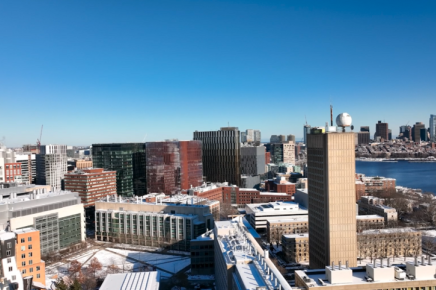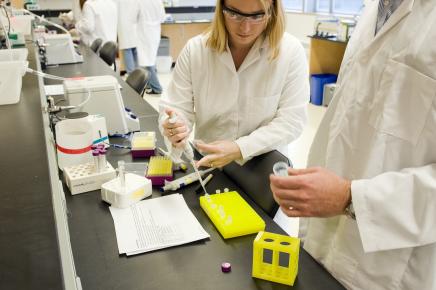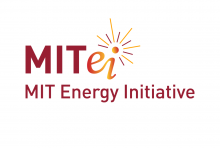What are MIT’s greenhouse gas reduction commitments?
With Fast Forward: MIT’s Climate Action Plan for the Decade (announced in May 2021) MIT set a goal of eliminating direct emissions from its campus by 2050. An important near-term milestone will be achieving net-zero emissions by 2026.
What is a net zero commitment versus a zero emissions commitment?
Net-zero emissions on a global-scale means cutting greenhouse gas emissions worldwide to as close to zero as possible, and then removing an equal amount of remaining emissions from the atmosphere. For an institution to achieve net-zero emissions, by way of a net zero commitment, this entails taking action to reduce its own emissions from sources under its direct control and then taking actions that reduce emissions elsewhere at an amount equivalent to what it could not reduce itself. When this balance of emissions is achieved, an institution has reached net-zero emissions and is considered not contributing to the buildup of greenhouse gases in the Earth’s atmosphere.
Zero emissions means that no direct greenhouse gases are released through the operation of an organization's owned buildings and fleet and a zero emissions commitment pledges to achieve this by a certain future date.
What is a power purchase agreement?
As renewable energy project developers look to secure financing for the construction of a wind or solar farm, they often seek to obtain a loan. Lenders will typically look at the revenue stream expected from the project and lend against that forecasted revenue. Power purchase agreements (PPA) provide developers with an extremely predictable and secure revenue stream that banks are comfortable lending against. Therefore, PPAs have a direct impact on whether a project will get financed and built. If demand for PPAs increases, this signals to developers that there is demand for renewable energy projects and will stimulate project development.
What is a carbon offset?
Carbon offsets are tradable “rights” or certificates linked to activities that lower the amount of carbon dioxide (CO2) in the atmosphere. By buying these certificates—which can be purchased for any geographic location across the globe—a person or group can fund projects that fight climate change. In some instances, this may be done in place of taking actions to lower one’s own carbon emissions or in addition to. In this way, the certificates “offset” the buyer’s CO2 emissions with an equal amount of CO2 reductions somewhere else.
Does the MIT Central Utilities Plant produce electricity cleaner than ISO New England?
In 2021, MIT completed a major upgrade of the district energy system whereby most buildings on campus now benefit from the most advanced cogeneration technology for combined heating, cooling, and power delivery. Through the focused system efficiencies, this system generates electrical power that produces 15 to 25 percent less carbon than the current New England grid.
What technologies and strategies are being considered by MIT for decarbonizing the campus?
MIT’s ability to adapt its district energy system (generation, distribution and building systems) and use new technologies is crucial as the Institute works in collaboration with faculty, students, industry experts, peer institutions, and the cities of Cambridge and Boston, for evolving into a next-generation district energy system.
Strategies which are being considered include electric steam boilers, commercial and industrial-scale heat pumps, thermal batteries, geothermal exchange, river water, micro-reactors, bio-based fuels, and green hydrogen produced from renewable energy, all while reducing consumption and demand at our building assets.
Additionally, MIT will continue to partner with our local electric utility and balance electrical export/import as the grid decarbonizes.
MIT will incorporate the most beneficial technologies into a blueprint that will help reach the 2050 goal.
How does MIT engage with outside companies in pursuit of the above?
MIT has had strong and long-term partnerships with energy and decarbonation services industry experts. Through our competitive bid process and proper vetting, MIT will work with outside subject matter experts to frame and develop decarbonization pathways, policy, and city and utility engagement.
In addition to engaging with outside services firms, MIT has met with peers and corporations in an effort to evaluate pros and cons of various solutions and technologies.
What is Scope 3 and how does MIT account for it?
Scope 3 emissions are those resulting from activities or assets not owned or controlled by the reporting institution, but which support the activities of a reporting organization. Examples of Scope 3 emissions may be sponsored travel, commuting, or capital goods.
Since 2018, work has been done to build preliminary estimates and develop methods for comprehensive data analysis of Scope 3 greenhouse gas emissions activities. The Institute’s Scope 3 activities — as framed by the Scope 3 protocol developed by the World Resources Institute and the World Business Council for Sustainable Development — include goods purchased by MIT, MIT-sponsored travel, employee commuting, campus-generated waste, and MIT capital goods such as building construction materials and large equipment. The protocol provides a standard algorithm by which to collect and calculate this data.
What role will electric vehicle infrastructure play in MIT’s plan for decarbonization?
MIT is committed to eliminating campus emissions from Scopes 1 and 2—including buildings and fleet—no later than 2050. In light of this commitment, MIT is working to replace its current fleet of vehicles with alternative electric vehicle (EV) models when available on the market. MIT’s campus fleet has approximately 144 vehicles with the potential to be replaced with EV vehicles as the market evolves.
The student-led Electric Vehicles Research Team worked alongside MIT staff and researchers to study the costs for replacing existing vehicles with EVs on the market now, versus buying new gas vehicles or leaving the existing ones in place. The research team produced a set of specific recommendations about fleet vehicle replacement and charging infrastructure installation on campus that supports both commuters and an MIT EV fleet in the future. Research found that there is not a drastic difference in the cost of new EVs versus new gas-powered vehicles.















































